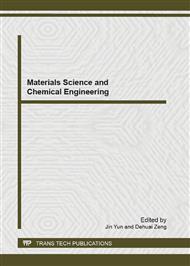p.541
p.549
p.554
p.557
p.560
p.566
p.572
p.578
p.584
Effects of the Polypyrrole/Silica on the Output Force of Ionic Polymer-Metal Composite
Abstract:
In this paper, a polypyrrole (PPy)/SiO2 composite filler prepared via in situ polymerization of pyrrole (Py) on SiO2 particles was incorporated into Nafion to improve the performance of ionic polymer-metal composite (IPMC) actuators. A transmission electron microscope (TEM) was used to observe the morphology of the prepared PPy/SiO2. IPMC with 1% and 2% PPy/SiO2 was synthesized, and the elastic modulus, the electric current, the blocking force and the water retention ability were measured on the test apparatus. Results showed that IPMC with 1% PPy/SiO2 composite, synthesized with 0.5ml Py, exhibited the best mechanical property. Compared with the pure Nafion-IPMC, the blocking force of PPy/SiO2/Nafion-IPMC with the optimized filler content (34.68 mN) at the sinusoidal voltage of 3 V and 0.1Hz was 2.3 times higher. Such significantly improved performance was attributed to the PPy’s redox reaction, which facilitates the ion transport in IPMC. Furthermore, the reasonable amount of the PPy and PPy/SiO2 plays an important role in fabricating the homogeneously distributed PPy/SiO2/Nafion membrane.
Info:
Periodical:
Pages:
560-565
Citation:
Online since:
May 2013
Authors:
Keywords:
Price:
Сopyright:
© 2013 Trans Tech Publications Ltd. All Rights Reserved
Share:
Citation:


